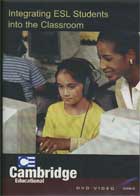
Integrating ESL Students into the Classroom 2006
Distributed by Films Media Group, PO Box 2053, Princeton, New Jersey 08543-2053; 800-257-5126
Produced by Chris Sherer of Films for the Humanities and Sciences and Jerry Baber for Fabian-Baber Communications
Director n/a
DVD, color, 22 min.
Adult
Language, Education
Date Entered: 04/04/2007
Reviewed by Linda Ryan, Network for Instructional TV, Inc.The overall purpose of the DVD Integrating ESL Students into the Classroom is to provide assistance to regular classroom teachers (not ESL/ELL instructors) who have limited English speaking students in their classroom. This docu-drama begins by reviewing TESOL’s (Teachers of English to Speakers of Other Languages) goals for ELL students. Concrete suggestions about what to do the first few days of the student’s entry in class accompany the filming of a “new” ESL student in a high school classroom. Besides helping ease the student’s initial days in the class, other helpful ideas include using the classroom students as buddies, helpers, and resources, looking to the school ESL teacher for hints, using administration and families to help integrate the student into the mainstream class, and using specific techniques for modifying materials and meeting the specific needs of the student. Explanation of some of the problems and concerns of limited English speakers is a good beginning to helping instructors understand special needs of the students, but more in-depth analysis of additional problems might be useful. Using the ESL student as a classroom resource is an excellent suggestion, but the usage of bi-lingual materials is controversial among ESL professionals, and none of the pro’s and con’s to such material selection is addressed. The main scope of the DVD includes focus on three main techniques, communication based instruction, grammar based instruction, and sheltered instruction. Each approach is fully explained and illustrated although the grammar based instruction module could have been expanded. The three sections are presented in a well-organized manner but are merely jumping off points for further technique development; they are general enough to allow teachers to adjust them to the types of students they find in their classrooms. The suggestions made are indeed techniques used by professional ESL instructors. The techniques used are backed by the philosophy of using a very positive approach to the student and his/her abilities. One limitation of the DVD is that the ESL student shown in the filming is already a high level English speaker with sophisticated vocabulary, self-awareness, and an exemplary educational background. Inexperienced teachers might have difficulty adapting the way he responds to verbal instruction, for example, to use with beginning ESL students with very few aural and speaking skills and little active English vocabulary.
Filming is high quality, and the sound is clear and natural although the spoken English is slower than the normal speaking rate of native speakers. Adequate editing and frequent jumps between the classroom setting and remarks by professions keep the viewer interested and stimulated. Sections of the DVD introduced with clear headings and bullet points with headings clearly indicate the outline of the content. Vocabulary used that may be new to regular classroom teachers is well-explained.
This DVD is a useful addition to an education library in the language teaching section. It could also be included with other applied linguistics or English as a second language materials.
Recommended